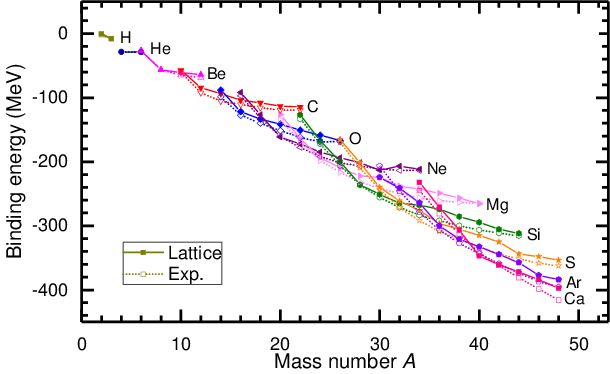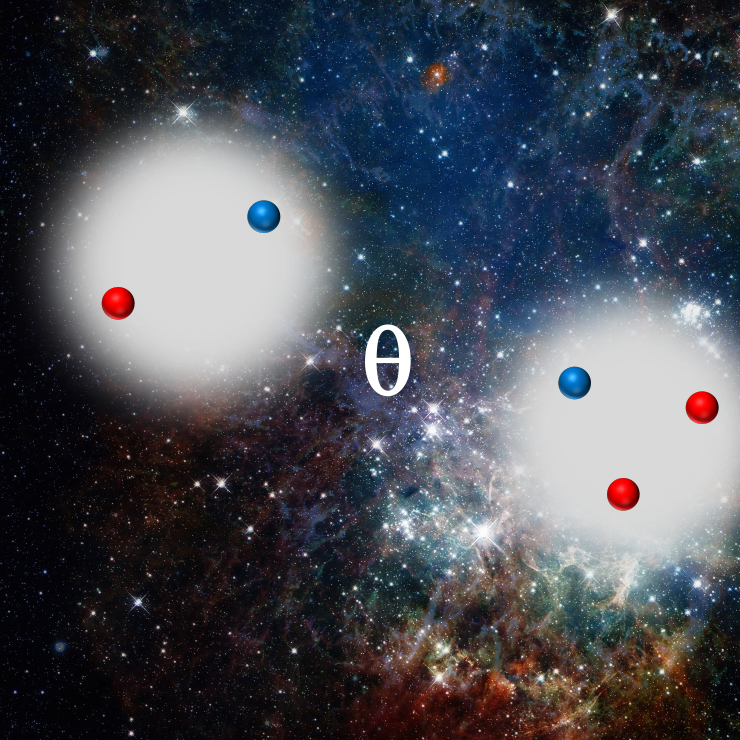| Project 1: Precision calculations of the nuclear drip line |
 The nuclear drip line is the boundary delimiting the zone beyond which atomic nuclei
decay by the emission of a proton or neutron (or two protons/neutrons).
The aim of this project is to precisely pin down the driplines up to the mid
mass region of the nuclear chart. This requires further improvements in the
machinery of NLEFT to precisely control the strong and the electromagnetic interactions
for the last weekly bound nucleon(s). These investigations include:
(1) Work out the continuum coupling in the framework of NLEFT. (2) Construct improved
actions based on the Wigner SU(4) symmetry, the chiral expansion, second order many-body
perturbation theory as well as local and non-local smearings of the involved operators.
(3) Perform case studies for light systems with one or two loosely bound nucleons.
(4) Calculate the neutron-rich oxygen isotopes and (5) Calculate the isotope chains
of carbon and calcium.
The nuclear drip line is the boundary delimiting the zone beyond which atomic nuclei
decay by the emission of a proton or neutron (or two protons/neutrons).
The aim of this project is to precisely pin down the driplines up to the mid
mass region of the nuclear chart. This requires further improvements in the
machinery of NLEFT to precisely control the strong and the electromagnetic interactions
for the last weekly bound nucleon(s). These investigations include:
(1) Work out the continuum coupling in the framework of NLEFT. (2) Construct improved
actions based on the Wigner SU(4) symmetry, the chiral expansion, second order many-body
perturbation theory as well as local and non-local smearings of the involved operators.
(3) Perform case studies for light systems with one or two loosely bound nucleons.
(4) Calculate the neutron-rich oxygen isotopes and (5) Calculate the isotope chains
of carbon and calcium.
|
| Project 2: Strange nuclei and the nuclear equation of state |
 The main objective of this project is the exploration of the third dimension of the nuclear chart,
i.e. the landscape of hypernuclei, but also to investigate further constraints on the underlying
baryon-baryon interactions and obtaining an improved understanding of the flavor SU(3) breaking in QCD.
Parallel to this, the effect of
strange quarks on the neutron matter EoS should be investigated, requiring new algorithmic
developments. These investigations include: (1) calculations of single-Lambda hypernuclei
into the mid-mass region. (2) charge symmetry-breaking effects in 4ΛH and 4ΛHe.
(3) Extension of the impurity MC formalism to two impurities. (4) Calculation of exotic hypernuclei
with two or more hyperons and (5) the effect of strange quarks on the neutron EoS,
for which in a first step new algorithmic developments are required to overcome the fermion
sign problem in such a system.
The main objective of this project is the exploration of the third dimension of the nuclear chart,
i.e. the landscape of hypernuclei, but also to investigate further constraints on the underlying
baryon-baryon interactions and obtaining an improved understanding of the flavor SU(3) breaking in QCD.
Parallel to this, the effect of
strange quarks on the neutron matter EoS should be investigated, requiring new algorithmic
developments. These investigations include: (1) calculations of single-Lambda hypernuclei
into the mid-mass region. (2) charge symmetry-breaking effects in 4ΛH and 4ΛHe.
(3) Extension of the impurity MC formalism to two impurities. (4) Calculation of exotic hypernuclei
with two or more hyperons and (5) the effect of strange quarks on the neutron EoS,
for which in a first step new algorithmic developments are required to overcome the fermion
sign problem in such a system.
|
| Project 3: How fine-tuned is nucleosynthesis? |
 It is also possible that our Universe with its observed fundamental parameters is part of a larger
structure or a Multiverse. In this case, the observed values may be somewhat random with no deep
explanation. However, even in that case, our specific measurements of these parameters can not be
completely random, as not all values will permit a Universe which supports our form of life,
which can carry out such measurements. This is often referred to as the anthropic principle.
In this project, we will elucidate the fine-tunings in nucleonsynthesis. These investigations
include: (1) The effect of varying strange quark masses on Big Bang Nucleosynthesis.
(2) 4He-4He scattering in the Multiverse. (3) 4He-8Be scattering in the multiverse.
(4) The calculation of the "holy grail" of nuclear astrophysics, 12C(α,γ)16O
at stellar energies, as a function of the light quark masses and of θ.
It is also possible that our Universe with its observed fundamental parameters is part of a larger
structure or a Multiverse. In this case, the observed values may be somewhat random with no deep
explanation. However, even in that case, our specific measurements of these parameters can not be
completely random, as not all values will permit a Universe which supports our form of life,
which can carry out such measurements. This is often referred to as the anthropic principle.
In this project, we will elucidate the fine-tunings in nucleonsynthesis. These investigations
include: (1) The effect of varying strange quark masses on Big Bang Nucleosynthesis.
(2) 4He-4He scattering in the Multiverse. (3) 4He-8Be scattering in the multiverse.
(4) The calculation of the "holy grail" of nuclear astrophysics, 12C(α,γ)16O
at stellar energies, as a function of the light quark masses and of θ.
|

 The nuclear drip line is the boundary delimiting the zone beyond which atomic nuclei
decay by the emission of a proton or neutron (or two protons/neutrons).
The aim of this project is to precisely pin down the driplines up to the mid
mass region of the nuclear chart. This requires further improvements in the
machinery of NLEFT to precisely control the strong and the electromagnetic interactions
for the last weekly bound nucleon(s). These investigations include:
(1) Work out the continuum coupling in the framework of NLEFT. (2) Construct improved
actions based on the Wigner SU(4) symmetry, the chiral expansion, second order many-body
perturbation theory as well as local and non-local smearings of the involved operators.
(3) Perform case studies for light systems with one or two loosely bound nucleons.
(4) Calculate the neutron-rich oxygen isotopes and (5) Calculate the isotope chains
of carbon and calcium.
The nuclear drip line is the boundary delimiting the zone beyond which atomic nuclei
decay by the emission of a proton or neutron (or two protons/neutrons).
The aim of this project is to precisely pin down the driplines up to the mid
mass region of the nuclear chart. This requires further improvements in the
machinery of NLEFT to precisely control the strong and the electromagnetic interactions
for the last weekly bound nucleon(s). These investigations include:
(1) Work out the continuum coupling in the framework of NLEFT. (2) Construct improved
actions based on the Wigner SU(4) symmetry, the chiral expansion, second order many-body
perturbation theory as well as local and non-local smearings of the involved operators.
(3) Perform case studies for light systems with one or two loosely bound nucleons.
(4) Calculate the neutron-rich oxygen isotopes and (5) Calculate the isotope chains
of carbon and calcium.
 The main objective of this project is the exploration of the third dimension of the nuclear chart,
i.e. the landscape of hypernuclei, but also to investigate further constraints on the underlying
baryon-baryon interactions and obtaining an improved understanding of the flavor SU(3) breaking in QCD.
Parallel to this, the effect of
strange quarks on the neutron matter EoS should be investigated, requiring new algorithmic
developments. These investigations include: (1) calculations of single-Lambda hypernuclei
into the mid-mass region. (2) charge symmetry-breaking effects in 4ΛH and 4ΛHe.
(3) Extension of the impurity MC formalism to two impurities. (4) Calculation of exotic hypernuclei
with two or more hyperons and (5) the effect of strange quarks on the neutron EoS,
for which in a first step new algorithmic developments are required to overcome the fermion
sign problem in such a system.
The main objective of this project is the exploration of the third dimension of the nuclear chart,
i.e. the landscape of hypernuclei, but also to investigate further constraints on the underlying
baryon-baryon interactions and obtaining an improved understanding of the flavor SU(3) breaking in QCD.
Parallel to this, the effect of
strange quarks on the neutron matter EoS should be investigated, requiring new algorithmic
developments. These investigations include: (1) calculations of single-Lambda hypernuclei
into the mid-mass region. (2) charge symmetry-breaking effects in 4ΛH and 4ΛHe.
(3) Extension of the impurity MC formalism to two impurities. (4) Calculation of exotic hypernuclei
with two or more hyperons and (5) the effect of strange quarks on the neutron EoS,
for which in a first step new algorithmic developments are required to overcome the fermion
sign problem in such a system.
 It is also possible that our Universe with its observed fundamental parameters is part of a larger
structure or a Multiverse. In this case, the observed values may be somewhat random with no deep
explanation. However, even in that case, our specific measurements of these parameters can not be
completely random, as not all values will permit a Universe which supports our form of life,
which can carry out such measurements. This is often referred to as the anthropic principle.
In this project, we will elucidate the fine-tunings in nucleonsynthesis. These investigations
include: (1) The effect of varying strange quark masses on Big Bang Nucleosynthesis.
(2) 4He-4He scattering in the Multiverse. (3) 4He-8Be scattering in the multiverse.
(4) The calculation of the "holy grail" of nuclear astrophysics, 12C(α,γ)16O
at stellar energies, as a function of the light quark masses and of θ.
It is also possible that our Universe with its observed fundamental parameters is part of a larger
structure or a Multiverse. In this case, the observed values may be somewhat random with no deep
explanation. However, even in that case, our specific measurements of these parameters can not be
completely random, as not all values will permit a Universe which supports our form of life,
which can carry out such measurements. This is often referred to as the anthropic principle.
In this project, we will elucidate the fine-tunings in nucleonsynthesis. These investigations
include: (1) The effect of varying strange quark masses on Big Bang Nucleosynthesis.
(2) 4He-4He scattering in the Multiverse. (3) 4He-8Be scattering in the multiverse.
(4) The calculation of the "holy grail" of nuclear astrophysics, 12C(α,γ)16O
at stellar energies, as a function of the light quark masses and of θ.